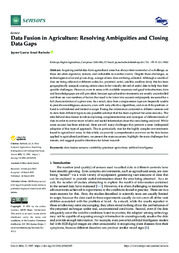Data fusion in agriculture: resolving ambiguities and closing data gaps.
Data fusion in agriculture: resolving ambiguities and closing data gaps.
Author(s): BARBEDO, J. G. A.
Summary: Abstract. Acquiring useful data from agricultural areas has always been somewhat of a challenge, as these are often expansive, remote, and vulnerable to weather events. Despite these challenges, as technologies evolve and prices drop, a surge of new data are being collected. Although a wealth of data are being collected at different scales (i.e., proximal, aerial, satellite, ancillary data), this has been geographically unequal, causing certain areas to be virtually devoid of useful data to help face their specific challenges. However, even in areas with available resources and good infrastructure, data and knowledge gaps are still prevalent, because agricultural environments are mostly uncontrolled and there are vast numbers of factors that need to be taken into account and properly measured for a full characterization of a given area. As a result, data from a single sensor type are frequently unable to provide unambiguous answers, even with very effective algorithms, and even if the problem at hand is well defined and limited in scope. Fusing the information contained in different sensors and in data from different types is one possible solution that has been explored for some decades. The idea behind data fusion involves exploring complementarities and synergies of different kinds of data in order to extract more reliable and useful information about the areas being analyzed. While some success has been achieved, there are still many challenges that prevent a more widespread adoption of this type of approach. This is particularly true for the highly complex environments found in agricultural areas. In this article, we provide a comprehensive overview on the data fusion applied to agricultural problems; we present the main successes, highlight the main challenges that remain, and suggest possible directions for future research.
Publication year: 2022
Types of publication: Journal article
Observation
Some of Embrapa's publications are published as ePub files. To read them, use or download one of the following free software options to your computer or mobile device. Android: Google Play Books; IOS: iBooks; Windows and Linux: Calibre.
Access other publications
Access the Agricultural Research Database (BDPA) to consult Embrapa's full library collection and records.
Visit Embrapa Bookstore to purchase books and other publications sold by Embrapa.

